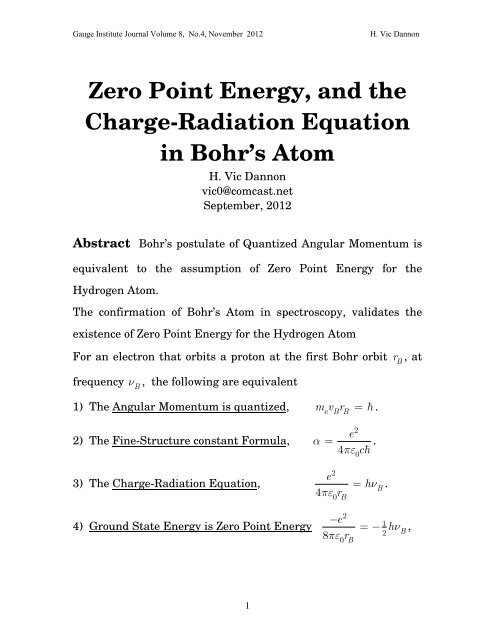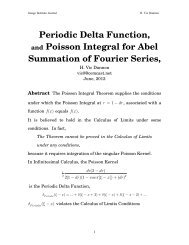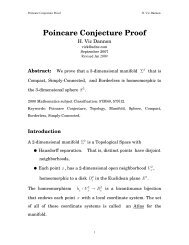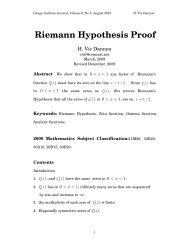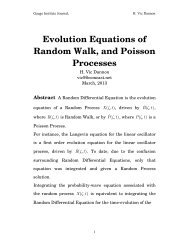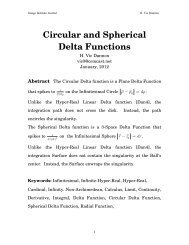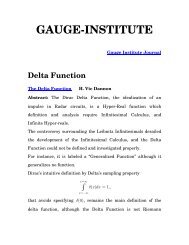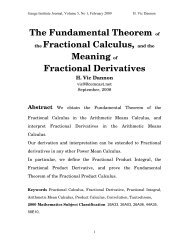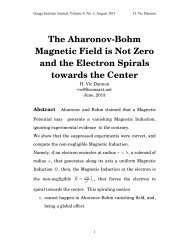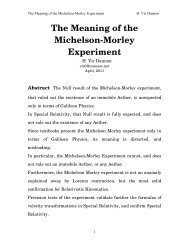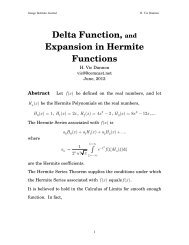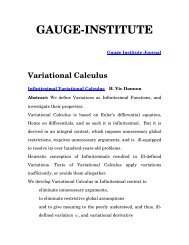Zero Point Energy and the Charge-Radiation Equation
Zero Point Energy and the Charge-Radiation Equation
Zero Point Energy and the Charge-Radiation Equation
Create successful ePaper yourself
Turn your PDF publications into a flip-book with our unique Google optimized e-Paper software.
Gauge Institute Journal Volume 8, No.4, November 2012 H. Vic Dannon<br />
<strong>Zero</strong> <strong>Point</strong> <strong>Energy</strong>, <strong>and</strong> <strong>the</strong><br />
<strong>Charge</strong>-<strong>Radiation</strong> <strong>Equation</strong><br />
in Bohr’s Atom<br />
H. Vic Dannon<br />
vic0@comcast.net<br />
September, 2012<br />
Abstract Bohr’s postulate of Quantized Angular Momentum is<br />
equivalent to <strong>the</strong> assumption of <strong>Zero</strong> <strong>Point</strong> <strong>Energy</strong> for <strong>the</strong><br />
Hydrogen Atom.<br />
The confirmation of Bohr’s Atom in spectroscopy, validates <strong>the</strong><br />
existence of <strong>Zero</strong> <strong>Point</strong> <strong>Energy</strong> for <strong>the</strong> Hydrogen Atom<br />
For an electron that orbits a proton at <strong>the</strong> first Bohr orbit r , at<br />
frequency ν , <strong>the</strong> following are equivalent<br />
B<br />
1) The Angular Momentum is quantized, mv e Br B = � .<br />
2) The Fine-Structure constant Formula,<br />
3) The <strong>Charge</strong>-<strong>Radiation</strong> <strong>Equation</strong>,<br />
4) Ground State <strong>Energy</strong> is <strong>Zero</strong> <strong>Point</strong> <strong>Energy</strong><br />
1<br />
α<br />
2<br />
e<br />
=<br />
4πε<br />
c�<br />
.<br />
2<br />
e<br />
4πε<br />
r<br />
0<br />
B<br />
0<br />
2<br />
−e<br />
8πε<br />
r<br />
B<br />
0<br />
= hν<br />
.<br />
B<br />
1<br />
2<br />
B<br />
=− hν<br />
,<br />
B
Gauge Institute Journal Volume 8, No.4, November 2012 H. Vic Dannon<br />
ν = 6.576928348 × 10 cycles/second<br />
B<br />
The Electron’s Magnetic <strong>Energy</strong> in <strong>the</strong> Bohr Orbit is<br />
magnetic 0 B B 2 0 B r<br />
15<br />
1 2 2 1 2 2<br />
μ ν μ v e<br />
4 (4 π)<br />
B<br />
U = r e = 1<br />
It is negligible compared to its Electric <strong>Energy</strong>.<br />
For an electron in <strong>the</strong> n th Bohr orbit , at frequency , ν<br />
<strong>the</strong> following are equivalent<br />
rn n<br />
1) The Angular Momentum is quantized, mvr = n�.<br />
2) The <strong>Charge</strong>-<strong>Radiation</strong> <strong>Equation</strong>,<br />
3) Orbit <strong>Energy</strong> is of n photons,<br />
hνn<br />
e nn<br />
2<br />
e<br />
4πε<br />
r<br />
0 n<br />
2<br />
−e<br />
8πε<br />
r<br />
= nhν<br />
.<br />
0 n<br />
n<br />
=− nhν<br />
.<br />
Keywords: <strong>Zero</strong> <strong>Point</strong> <strong>Energy</strong>, Bohr’s Atom, Quantized Angular<br />
Momentum, Fine Structure Constant, Electron, Photon, Proton,<br />
Binding Electric <strong>Energy</strong>, <strong>Radiation</strong> <strong>Energy</strong>, <strong>Charge</strong>-<strong>Radiation</strong><br />
<strong>Equation</strong><br />
2000 Physics <strong>and</strong> Astronomy Classification Scheme<br />
03.50.Kk, 03.65.-w.<br />
2<br />
1<br />
2<br />
�<br />
1<br />
n<br />
2<br />
hν<br />
n<br />
B
Gauge Institute Journal Volume 8, No.4, November 2012 H. Vic Dannon<br />
Introduction<br />
In 1901, Planck showed that <strong>the</strong> radiation-energy density per unit<br />
volume at frequencies between ν , <strong>and</strong> ν + δν of an ideal radiator<br />
(black body) is<br />
8 2 h<br />
u(, T)<br />
3 h<br />
c e kT 1<br />
ν<br />
π ν<br />
ν = ν .<br />
−<br />
The assumption of discrete radiation energy, conflicted with<br />
Planck’s belief in radiation of continuous waves, <strong>and</strong> he kept<br />
searching for a more believable law<br />
To reconcile his quantum hypo<strong>the</strong>sis with his conception of wave<br />
radiation, he avoided <strong>the</strong> conclusion that radiation energy must be<br />
made of particles, <strong>and</strong> postulated that radiation is a transition<br />
between <strong>the</strong> energy levels of an oscillator. Fur<strong>the</strong>rmore, ignoring<br />
<strong>the</strong> symmetry between emission <strong>and</strong> absorption, he maintained<br />
that <strong>the</strong> absorption of radiation energy is continuous.<br />
Under <strong>the</strong>se assumptions, Planck derived in 1912 his second<br />
radiation law in which zero point energy in <strong>the</strong> amount of 1 hν is<br />
2<br />
added to<br />
h<br />
h<br />
e kT 1<br />
ν<br />
ν<br />
, of his 1901 radiation law.<br />
−<br />
In [Dan], we showed that Planck’s derivation of his 1912 radiation<br />
law only recovers <strong>the</strong> <strong>Zero</strong> <strong>Point</strong> <strong>Energy</strong> that he unknowingly<br />
3
Gauge Institute Journal Volume 8, No.4, November 2012 H. Vic Dannon<br />
assumed in his model for that derivation.<br />
In particular, we showed that Planck’s ZPE radiation law is<br />
equivalent to <strong>the</strong> combined three assumptions of<br />
1) <strong>Zero</strong> <strong>Point</strong> <strong>Energy</strong> Hypo<strong>the</strong>sis,<br />
2) <strong>the</strong> Quantum Law, <strong>and</strong><br />
3) <strong>the</strong> approximated Boson Statistics distribution law.<br />
Planck’s 1901 radiation law resolves <strong>the</strong> Black body radiation<br />
problem, <strong>and</strong> confirms <strong>the</strong> boson statistics distribution law.<br />
The Quantum law holds independently in <strong>the</strong> photoelectric effect,<br />
in Compton’s scattering, <strong>and</strong> in spectroscopy.<br />
But Planck’s <strong>Zero</strong> <strong>Point</strong> <strong>Energy</strong> remains a hypo<strong>the</strong>sis. Thus, <strong>the</strong><br />
validity of Planck’s 1912 radiation law, <strong>and</strong> <strong>the</strong> existence of<br />
Planck’s <strong>Zero</strong> <strong>Point</strong> <strong>Energy</strong> are doubtful.<br />
However, we will show here that Bohr’s postulate of Quantized<br />
Angular Momentum is equivalent to <strong>the</strong> assumption of <strong>Zero</strong> <strong>Point</strong><br />
<strong>Energy</strong> for <strong>the</strong> Hydrogen Atom.<br />
The confirmation of Bohr’s Atom in spectroscopy, validates <strong>the</strong><br />
existence of <strong>Zero</strong> <strong>Point</strong> <strong>Energy</strong> for <strong>the</strong> Hydrogen Atom.<br />
0.1 Bohr’s Quantized Angular Momentum<br />
Consider an electron with mass m , <strong>and</strong> charge e , in <strong>the</strong> first<br />
Bohr orbit of radius r r , at frequency ν = ν , <strong>and</strong> speed<br />
1 = B<br />
1 B<br />
4<br />
e
Gauge Institute Journal Volume 8, No.4, November 2012 H. Vic Dannon<br />
v = v = ω r = 2πν<br />
rB<br />
,<br />
1<br />
B B B B<br />
encircling a proton with charge −e<br />
,<br />
An electron with charge e , orbiting at frequency ν , <strong>and</strong> speed<br />
v = αc = ωr = 2πν<br />
, a proton with charge e at distance . r<br />
1 1 1 1 r 1<br />
1<br />
− 1<br />
Bohr postulated that <strong>the</strong> angular momentum is quantized:<br />
For <strong>the</strong> electron’s first, Bohr’s orbit, n = 1,<br />
<strong>and</strong><br />
mvr<br />
= � = .<br />
h<br />
e 11 2π<br />
For <strong>the</strong> electron’s 2 nd orbit, n = 2 , <strong>and</strong><br />
mvr<br />
2 2 h = � = ,<br />
e 2 2 2π<br />
For <strong>the</strong> 3 rd electron orbit, n = 3,<br />
<strong>and</strong><br />
mvr<br />
3 3 h = � = ,<br />
e 3 3 2π<br />
………………………………………..<br />
5
Gauge Institute Journal Volume 8, No.4, November 2012 H. Vic Dannon<br />
Angular Momentum is <strong>the</strong> vector product<br />
� � � � �<br />
mv × r = m( ω × r ) × r ,<br />
<strong>and</strong> <strong>the</strong> quantization of that quantity cannot be visualized like <strong>the</strong><br />
quantization of a scalar quantity, such as energy.<br />
We aim to show that Quantized Angular Momentum is equivalent<br />
to <strong>the</strong> assumption of <strong>Zero</strong> <strong>Point</strong> <strong>Energy</strong> for Bohr’s Atom.<br />
We’ll first show that Quantized Angular Momentum is equivalent<br />
to <strong>the</strong> Fine-Structure constant.<br />
0.2 The Fine-Structure Constant<br />
Sommerfeld suggested that<br />
α<br />
2<br />
e<br />
=<br />
4πε<br />
c�<br />
,<br />
determines <strong>the</strong> spacing between <strong>the</strong> fine structure of spectral<br />
lines.<br />
α , known as <strong>the</strong> Fine Structure Constant, is a pure number that<br />
is approximately 1<br />
137<br />
in any unit system.<br />
The fine-structure constant depends on fundamental constants,<br />
� e , <strong>the</strong> electron charge, which was thought to be <strong>the</strong> smallest<br />
electric charge,<br />
� c , light speed in <strong>the</strong> vacuum, which is thought to be <strong>the</strong><br />
greatest speed,<br />
6<br />
0
Gauge Institute Journal Volume 8, No.4, November 2012 H. Vic Dannon<br />
� h = 2π�<br />
, Planck Constant of radiation energy,<br />
ε = , <strong>the</strong> permittivity of <strong>the</strong> vacuum.<br />
1 � 0 2 μ0c<br />
Consequently, it was suspected to hide some truth of nature.<br />
Eddington, Pauli, <strong>and</strong> <strong>the</strong>ir contemporaries [Miller] searched for a<br />
meaning for <strong>the</strong> appearance of <strong>the</strong>se fundamental constant in one<br />
formula.<br />
We show that <strong>the</strong> Formula for <strong>the</strong> Fine Structure Constant can be<br />
written in a form that equates <strong>the</strong> electron-proton binding electric<br />
energy to <strong>the</strong> radiation energy of a photon.<br />
We call that equivalent form <strong>the</strong> <strong>Charge</strong>-<strong>Radiation</strong> equation.<br />
0.3 The <strong>Charge</strong>-<strong>Radiation</strong> <strong>Equation</strong><br />
The binding electric energy<br />
e<br />
2<br />
4πε0rB of <strong>the</strong> electron in <strong>the</strong> first<br />
Bohr orbit with frequency ν , equals <strong>the</strong> radiation energy<br />
rB B<br />
hνB B<br />
of a photon of frequency ν .<br />
The binding electric energy of <strong>the</strong> Hydrogen Atom in <strong>the</strong> ground<br />
state is precisely <strong>the</strong> radiation energy of a photon with frequency<br />
that equals <strong>the</strong> frequency of <strong>the</strong> electron motion.<br />
The <strong>Charge</strong>-<strong>Radiation</strong> equation is equivalent to <strong>the</strong> equality of<br />
<strong>the</strong> electron’s energy in <strong>the</strong> ground state to 1 hν of <strong>Zero</strong> <strong>Point</strong><br />
7<br />
2<br />
B
Gauge Institute Journal Volume 8, No.4, November 2012 H. Vic Dannon<br />
radiation <strong>Energy</strong>.<br />
0.4 The <strong>Zero</strong> <strong>Point</strong> <strong>Energy</strong> of Bohr’s Atom<br />
The <strong>Zero</strong> <strong>Point</strong> <strong>Energy</strong> of Bohr’s Atom is <strong>the</strong> Ground state energy.<br />
Its value, 1 hν is <strong>the</strong> lowest energy of <strong>the</strong> Bohr Atom.<br />
2<br />
B<br />
The loss of that <strong>Zero</strong> <strong>Point</strong> <strong>Energy</strong>, would mean <strong>the</strong> destruction of<br />
<strong>the</strong> Atom.<br />
Therefore, at absolute zero temperature, when all <strong>the</strong>rmal<br />
motions cease, <strong>the</strong> atom still retains that amount of energy.<br />
The existence of <strong>Zero</strong> <strong>Point</strong> <strong>Energy</strong> has been always difficult to<br />
confirm in experiments. But <strong>the</strong> confirmation of Bohr’s<br />
quantization of Angular Momentum in spectroscopy, validates<br />
<strong>Zero</strong> <strong>Point</strong> <strong>Energy</strong> in <strong>the</strong> amount of 1 hν , for <strong>the</strong> Bohr Atom.<br />
8<br />
2<br />
B
Gauge Institute Journal Volume 8, No.4, November 2012 H. Vic Dannon<br />
1.<br />
Quantized Angular Momentum<br />
<strong>and</strong> <strong>the</strong> Fine Structure Constant<br />
1.1<br />
Proof:<br />
mv r<br />
B B<br />
e<br />
= � ⇔ α =<br />
4πε<br />
c�<br />
Ignoring <strong>the</strong> magnetic Field of <strong>the</strong> proton on <strong>the</strong> electron’s charge,<br />
<strong>the</strong> centripetal repulsion is balanced by <strong>the</strong> electric attraction<br />
2<br />
v 2<br />
B 1 e<br />
e<br />
4 2<br />
B πε0<br />
B<br />
m = .<br />
r r<br />
1<br />
mv r v = e<br />
������� 4πε<br />
e B B<br />
�<br />
B<br />
v<br />
B<br />
0<br />
2<br />
0<br />
1 e<br />
=<br />
4πε<br />
� ,<br />
v 2<br />
B 1 e<br />
=<br />
�c<br />
4πε<br />
� c<br />
.<br />
α<br />
9<br />
0<br />
2<br />
,<br />
2<br />
0
Gauge Institute Journal Volume 8, No.4, November 2012 H. Vic Dannon<br />
2.<br />
The Fine-Structure Constant <strong>and</strong><br />
<strong>the</strong> <strong>Charge</strong>-<strong>Radiation</strong> <strong>Equation</strong><br />
2.1<br />
Proof:<br />
Hence,<br />
Therefore,<br />
2 2<br />
e e<br />
α = ⇔ = hν<br />
4πε c�4πε r<br />
0 0<br />
α<br />
B<br />
2<br />
0<br />
B<br />
e<br />
=<br />
4πε<br />
c�<br />
,<br />
2<br />
e<br />
� =<br />
4πε<br />
αc<br />
=<br />
e<br />
0<br />
2<br />
4πε0vB 2<br />
e<br />
= .<br />
4πε0ωBrB 2<br />
e<br />
� ωB<br />
= .<br />
4πε<br />
r<br />
10<br />
0<br />
B
Gauge Institute Journal Volume 8, No.4, November 2012 H. Vic Dannon<br />
3.<br />
The <strong>Charge</strong>-<strong>Radiation</strong> <strong>Equation</strong><br />
<strong>and</strong> <strong>Zero</strong> <strong>Point</strong> <strong>Energy</strong><br />
3.1<br />
2 2<br />
1 2 2 −<br />
1<br />
= hνB ⇔ U1 st Orbit = mω 2 BrB + = −<br />
2<br />
0r ���������<br />
B 0rB<br />
U �������<br />
e e<br />
4πε 4πε<br />
Proof:<br />
Ignoring <strong>the</strong> magnetic forces,<br />
rotation<br />
U electric<br />
�����������������<br />
2<br />
−e<br />
8πε<br />
r<br />
2<br />
v 2<br />
B 1 e<br />
e<br />
4 2<br />
B πε0<br />
B<br />
0 B<br />
m = ,<br />
r r<br />
1m 2 e<br />
2<br />
v<br />
ω<br />
= 1<br />
2<br />
�B 2 2<br />
BrB 0<br />
hν<br />
2<br />
1 e<br />
,<br />
4πε<br />
r<br />
������� B<br />
The electron’s energy at <strong>the</strong> ground orbit is <strong>the</strong> sum of <strong>the</strong><br />
electron’s kinetic energy of rotation,<br />
1 2 2 1 2<br />
rotation ω<br />
2 B B 2 B<br />
U = m r = mv ,<br />
<strong>and</strong> <strong>the</strong> electron’s binding electric energy<br />
11<br />
B<br />
hν<br />
B
Gauge Institute Journal Volume 8, No.4, November 2012 H. Vic Dannon<br />
0<br />
U<br />
electric<br />
2<br />
−e<br />
= ,<br />
4πε0rB 2<br />
1 2 2 −e mω 2 BrB+ ������� 4πε 2 0rB 1 e<br />
2<br />
−e<br />
=<br />
8πε0rB<br />
1 = − hν<br />
2 B<br />
4πε<br />
r<br />
B<br />
In <strong>the</strong> Bohr orbit, <strong>the</strong> electron’s energy is of photon with energy<br />
− hν .<br />
1<br />
2<br />
That is, <strong>the</strong> Ground state <strong>Energy</strong> of <strong>the</strong> Bohr Atom is <strong>Zero</strong> <strong>Point</strong><br />
<strong>Energy</strong> of 1 hν .<br />
2<br />
B<br />
3.2 Bohr’s Atom <strong>Zero</strong> <strong>Point</strong> <strong>Energy</strong><br />
3.3<br />
1 1 e<br />
EB =− hν<br />
13.6eV<br />
2 B =− =−<br />
8πε<br />
r<br />
13.6eV<br />
15<br />
ν B = 2 = 6.576928348 × 10 cycles/second<br />
h<br />
Computation: h = 4.1356692 × 10 eV , [Woan].<br />
B<br />
−15<br />
12<br />
0<br />
2<br />
B<br />
.
Gauge Institute Journal Volume 8, No.4, November 2012 H. Vic Dannon<br />
4.<br />
The Electron’s magnetic <strong>Energy</strong><br />
4.1 Electron’s Total Quantized <strong>Energy</strong><br />
Bohr’s quantization of <strong>the</strong> Angular Momentum ignores <strong>the</strong><br />
electron’s Orbital Magnetic <strong>Energy</strong>, <strong>and</strong> <strong>the</strong> electron’s Spin<br />
Magnetic <strong>Energy</strong>.<br />
Including orbital magnetic forces, in <strong>the</strong> force balance, <strong>the</strong><br />
electron’s total quantized energy in <strong>the</strong> Bohr orbit is<br />
2<br />
e<br />
− + Umagnetic = hνB.<br />
8πε<br />
r<br />
4.2 The Electron’s Magnetic <strong>Energy</strong><br />
0<br />
B<br />
1 2 2<br />
magnetic = μ<br />
4 0 Be νB<br />
U r<br />
1<br />
=<br />
(4 π)<br />
2<br />
μ<br />
1<br />
2 2<br />
0vBe<br />
rB<br />
Proof: The current due to <strong>the</strong> electron’s charge e that turns<br />
cycles/second is<br />
I = eνB<br />
The Magnetic <strong>Energy</strong> of this current is [Benson, p.486]<br />
1<br />
2<br />
2<br />
LI .<br />
13<br />
νB
Gauge Institute Journal Volume 8, No.4, November 2012 H. Vic Dannon<br />
By [Fischer, p.97]<br />
2 πrB<br />
1<br />
0 2 0 B<br />
2πrB<br />
L = μ = μ r .<br />
Thus, <strong>the</strong> magnetic energy due to <strong>the</strong> electron charge is<br />
11 2 1 2 2<br />
μ<br />
22 0rB( eνB) = μ<br />
4 0rBe<br />
νB<br />
=<br />
1<br />
4<br />
2 2<br />
μ0erB ν<br />
�B<br />
1<br />
ω<br />
2<br />
4π<br />
2<br />
B<br />
1 2 2 1<br />
= μ<br />
2 0vBe<br />
.<br />
(4 π)<br />
r<br />
4.3 The Electron’s Magnetic <strong>Energy</strong> in <strong>the</strong> Bohr’s Orbit is<br />
Proof:<br />
negligible compared to its Electric <strong>Energy</strong><br />
1 1<br />
U r v<br />
2 2 μ0v<br />
2 Be<br />
2<br />
magnetic (4 π)<br />
B 1 B 1 2 1<br />
−6<br />
= = = α ≈ ≈ 8.5 × 10<br />
2 2 2 2 (137)<br />
electric 1<br />
2π 2π<br />
π<br />
U e c<br />
8πε<br />
0<br />
r<br />
B<br />
14<br />
B
Gauge Institute Journal Volume 8, No.4, November 2012 H. Vic Dannon<br />
5.<br />
The n th Orbit <strong>Charge</strong>-<strong>Radiation</strong><br />
In <strong>the</strong> n th orbit,<br />
<strong>the</strong> Angular momentum is mvr = n�,<br />
The orbit energy is<br />
5.1 The Electron’s <strong>Energy</strong><br />
Proof:<br />
5.2<br />
Proof:<br />
5.3<br />
E<br />
n<br />
e nn<br />
1<br />
=−<br />
8πε<br />
2 2<br />
1 2 2 −e −e<br />
1 2 2<br />
m<br />
2 eωnrnm 2 eωnrn<br />
4πε0rn 8πε0rn<br />
0 n<br />
α<br />
+ = = − = − � 1 c<br />
2 r<br />
r v<br />
+ = = = − = −<br />
1 2 2<br />
meω 2 nn r<br />
�������<br />
2 e<br />
2<br />
−e 4πε0rn 2<br />
−e 8πε0rn 2<br />
−e<br />
B<br />
8πε0rB<br />
r<br />
������� n<br />
1 B �<br />
2 rn<br />
4πε<br />
r<br />
− �ωB<br />
v<br />
2 2 ( e nn) n<br />
= = �<br />
n<br />
vB<br />
α<br />
= = c<br />
n n<br />
m ω r r αcα vnc mvr n� n<br />
=<br />
e n n<br />
2<br />
n = B<br />
r n r<br />
15<br />
1<br />
2<br />
0<br />
e<br />
r<br />
2<br />
n<br />
n<br />
1<br />
2<br />
�αc<br />
r<br />
n
Gauge Institute Journal Volume 8, No.4, November 2012 H. Vic Dannon<br />
Proof:<br />
n� n�<br />
�<br />
r n<br />
2 2<br />
n = = = = n r<br />
1<br />
B<br />
mv e n m mv<br />
e v<br />
n B<br />
e B<br />
5.4 ν = 1 ν 3<br />
Proof:<br />
n n B<br />
v<br />
ν = ω = = = ω = ν B<br />
1<br />
1 1 vn<br />
1 n B 1 1 1<br />
n 2π n 2π 2 2 3 2 B<br />
r π π<br />
3<br />
n nrB n n<br />
5.5 The Orbit <strong>Energy</strong><br />
Proof:<br />
E<br />
n<br />
1 1 1<br />
En = E ( )<br />
2 B = − hν<br />
2 2 B<br />
n n<br />
2 2<br />
1 e 1 e rB<br />
=− =−<br />
8πε0 rn 8πε0<br />
rB<br />
r<br />
������� �n<br />
1<br />
2<br />
hν<br />
5.6 The <strong>Charge</strong>-<strong>Radiation</strong> <strong>Equation</strong><br />
The binding electric energy<br />
B<br />
1<br />
n<br />
2<br />
e<br />
2<br />
4πε 0rn<br />
of <strong>the</strong> electron-proton<br />
Atom, where <strong>the</strong> electron is in <strong>the</strong> n th Bohr orbit r with<br />
frequency , equals <strong>the</strong> radiation energy nhν of n photons<br />
of frequency ν .<br />
νn n<br />
n<br />
16<br />
n
Gauge Institute Journal Volume 8, No.4, November 2012 H. Vic Dannon<br />
Proof:<br />
1<br />
4πε<br />
0<br />
1<br />
4πε<br />
0<br />
e<br />
r<br />
e �v<br />
r<br />
r r nr<br />
2<br />
n<br />
= nhν<br />
2<br />
n<br />
= B<br />
n<br />
= � ω<br />
�B 3<br />
n ω<br />
B<br />
2<br />
B<br />
= nhνn<br />
n<br />
17<br />
n
Gauge Institute Journal Volume 8, No.4, November 2012 H. Vic Dannon<br />
References<br />
[Benson], Benson Walter, Harris John, Stocker Horst, Lutz Holger,<br />
“H<strong>and</strong>book of Physics”, Springer, 2002.<br />
[Born] Max Born, “The Mechanics of <strong>the</strong> Atom”, Ungar Publishing, 1924<br />
[Dan] H. Vic Dannon, “<strong>Zero</strong> <strong>Point</strong> <strong>Energy</strong>: Planck <strong>Radiation</strong> Law” Gauge<br />
Institute Journal, Vol.1 No 3, August 2005,<br />
[Fischer] Fischer-Cripps, A., C., “The Physics Companion”, IoP, 2003.<br />
[Miller] Arthur I. Miller, “Deciphering <strong>the</strong> Cosmic Number” Norton, 2009<br />
[Polyanin] Andrei D. Polyanin, Alexi I. Chernoutsan, “A Concise H<strong>and</strong>book of<br />
Ma<strong>the</strong>matics, Physics, <strong>and</strong> Engineering Sciences” CRC, 2011.<br />
[Woan] Graham Woan, “The Cambridge H<strong>and</strong>book of Physics Formulas”,<br />
Cambridge 2000.<br />
18


